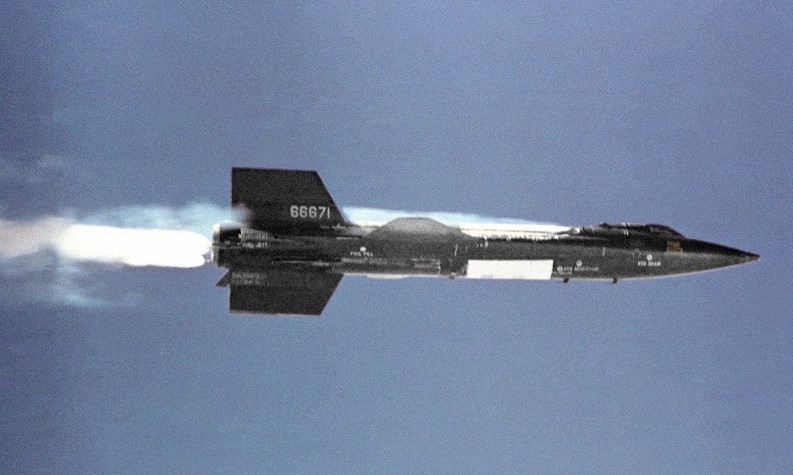From grooved runways to rocket planes, NASA has been at the cutting edge of aviation technology and is still pushing the envelope at age 60.
When it comes to aviation icons it’s hard to go past the X-15 rocket plane built by North American Aviation and operated jointly by NASA and the US Air Force.
The X-15 set the world record for the highest speed ever by a manned, powered aircraft in October 1967 when it flew at 6.73 times the speed of sound, or 4,520mph (7,274kmh) at an altitude or more than 100,000 ft.

Ultimately powered by a Thiokol XLR-99 rocket engine, it reached an altitude of 354,200ft and contributed greatly to the space program by providing valuable data on aerodynamics, structures, flight controls and the impact on humans of high-speed, high altitude flight.
READ: Red planet still beckons as NASA turns 60
The hypersonic plane was drop-launched from a B-52 bomber and flew 199 missions — a 200th flight was canceled because of technical problems — before it was retired.
But the X-15 may now have a competitor in an uber-cool new X-plane set to make supersonic travel easy by greatly limiting sonic booms.

The US space agency has awarded a $US247.5 million contract to Lockheed Martin to build from scratch a needle-nosed aircraft that could happily grace any chapter of the Star Wars franchise.
The 94-foot long plane is expected to start test flights in 2021 and fly at a cruising altitude of 55,000ft at Mach 1.42, or 940mph (1512kmh), with a top speed of Mach 1.5.
It will use the latest in supersonic technologies to reduce the window-shaking sonic boom to a thump equivalent to the noise of car door closing.
The single-pilot X plane will be propelled by a General Electric F414 engine used by F/A-18 fighters. A single pilot will be in a cockpit based on the design of the rear seat of the T-38 training jet famously used for years by NASA astronauts.
A tentative schedule sees a critical design configuration review in 2019 that, if successful, leads to the construction of the aircraft at Lockheed Martin’s Skunk Works facility in Palmdale, California, and delivery to NASA’s Armstrong Flight Research Center in 2021.
A second phase beginning 2022 will see NASA fly the plane at the supersonic test range in Edwards to prove the quiet supersonic technology works as expected and the plane is safe.
A series of trials will be conducted between 2022 and 2025 over four to six US cities to gauge community response to the technology.
NASA says key to success for the Low-Boom Flight Demonstrator will be sonic booms “so quiet, people on the ground will hardly notice them if they hear them at all”.
It plans to deliver the data to the Federal Aviation Administration (FAA) and the International Civil Aviation Organization (ICAO) in 2025 so they can develop and adopt new rules to allow commercial supersonic flight over land.
Nor have striking, needle-nosed planes been NASA’s only contribution to the world.
Computer technology developed for the Space Shuttle program is used in commercial and military aircraft while the variable density wind tunnel operated by NASA’s forerunner, NACA, at Langley from the 1920s put the agency at the forefront of global aeronautics research.

The test results from the variable density tunnel were superior to any previous design and made Langley a world leader in aerodynamic research for the next decade.
NASA’s research into high-speed aircraft improved many of the features in commercial aircraft and the agency helped develop the digital “fly-by-wire” system used in modern jetliners to control flight surfaces.
Winglets, the upturned tips of wings that save airlines billions in fuel costs, were also a product of advances made by NASA researchers.

On the ground, grooved runways developed by NASA in the 1960s to increase traction and stop aircraft sliding after landing are now used around the world.
There’s also an anti-icing system for single-engine planes.
The space agency says its most ubiquitous spinoff was the sensor now used in most digital cameras, video cameras and smartphones.
Invented at NASA’s Jet Propulsion Laboratory, the complementary metal oxide semiconductor (CMOS) image sensor was the brainchild of NASA scientist Eric Fossum and revolutionized photography.
Photo: NASA
Other spinoffs include a red light emitting diode used for growing plants in space that has been adapted to provide temporary relief from minor muscle and joint pain, the infrared ear thermometer and a life-saving heart pump.
NASA even had a hand, along with Black & Decker, in the development of compact cordless power tools and its ultra-strong alloys have had a dramatic effect on the way golf clubs and other sporting equipment is manufactured.
Packaging developed to keep food stable and safe for astronauts has improved food safety and home air purifiers use plug-in filters designed to help plants thrive in space.
Memory foam also came from NASA as did freeze-dried food and “space blankets” used by emergency services.
























